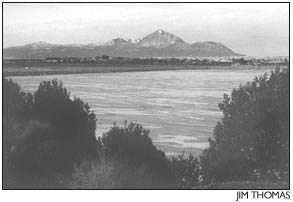|
Jan. 13, 2001
BY THE COLORADO DIVISION OF WILDLIFE DENVER ó As ice fishing season starts around the state, anglers are reminded to make safety their top priority before venturing onto frozen lakes and reservoirs. "Early season ice can be very dangerous," said Randy Van Buren, aquatic biologist for the Division of Wildlife in Fort Collins. "No fish is worth the possibility of breaking through unsafe ice." While some of the stateís higher elevation lakes are freezing to a point where ice fishing is safe, some east slope and west slope water bodies remain unsafe and possibly may be so for the entire winter. As a rule, many of the water bodies found along the Front Range, on the eastern plains and in the west slopeís Grand Valley never freeze solid enough to allow safe fishing. If they do so, it can only be for a short time period. A quick check of Totten Lake, located just east of Cortez, and McPhee Reservoir (Dolores side) was that there was still some open water in places. Colder temperatures are still needed before ice fishing would be safe. "Here in the Grand Valley, itís an unusual year when ice conditions are good enough to support a person walking out on the ice and fishing," said Bill Elmbad, aquatic biologist for the Division of Wildlife in Grand Junction. "However, a majority of our higher elevation reservoirs and lakes typically offer good ice for fishing through much of the winter." Ice fishing is okay at Trout Lake, located high up on Lizard Head Pass. Ice fishing should be okay at Groundhog Reservoir, located northwest of Dolores, as well. Two things factor into how much weight ice can support Ė its quality and its thickness. Clear solid ice is stronger than milky, cracked ice and, itís about 50 percent stronger than slushy ice. As ice ages it cracks, discolors and becomes weaker. Typically, at least 2 inches of clear solid ice is required to support one person walking and three or more inches are even better. Four inches of solid clear ice is usually the safe minimum for ice fishing. However, according to Van Buren more is better when it comes to ice. "I donít go out on ice until thereís at least five or six inches because then I know I can be sure of it," he said. "Another thing Iím careful about is checking the ice in more than one place as I move around a reservoir or lake." Ice thickness can vary across a waterbody. Springs, pressure ridges, snow cover, wind, water inflow and outflow and even the existence of waterfowl on a lake can all cause ice thickness to vary. Van Buren recommends fisherman systematically check the thickness of ice as they walk across a frozen waterbody. The first test hole they cut should be in shallow water. Reservoirs that receive water during the winter months can be dangerous, according to Elmblad. "Watch out for thin ice or open water around the shoreline at reservoirs that are filling," he said. "As a reservoir fills, you can have thick solid ice in its middle, but thin or no ice along its edge. Getting out to the good ice can be very tricky." Carrying safety equipment is always a good idea when ice fishing. At a minimum, ice anglers should wear an approved life vest and carry a pair of ice picks or stout screw drivers. Carrying a long length of rope should be considered too. The life vest can keep a person afloat if they break through, the ice picks can give a person the grip they need to pull themselves out of the water and the safety rope can be thrown to someone who has broken through. Never venture out on ice alone and be aware of quickly changing conditions that could make ice unsafe. The Division of Wildlife provides an updated report during the winter which includes information about ice and fishing conditions. The report can be found on the agencyís homepage at http://wildlife.state.co.us/fishing/fishcond.html or through a recorded message at 303-291-7534. Whenever possible, fisherman should consult local sources for information about ice conditions before planning a trip. Most importantly, fisherman should rely on themselves to make each ice fishing trip a safe one by carrying the proper safety equipment and testing the ice carefully before fishing. |
|||
|
Copyright © 2001 the Cortez Journal.
All rights reserved. |
